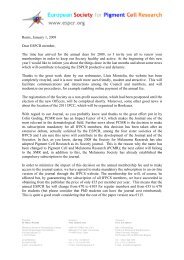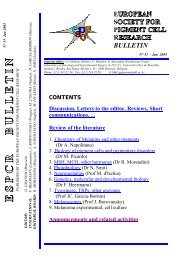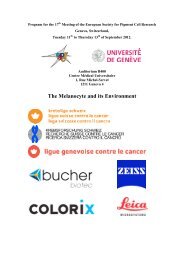espcrbulletin - European Society for Pigment Cell Research
espcrbulletin - European Society for Pigment Cell Research
espcrbulletin - European Society for Pigment Cell Research
Create successful ePaper yourself
Turn your PDF publications into a flip-book with our unique Google optimized e-Paper software.
Immobilization stress causes increases in tetrahydrobiopterin, dopamine, and neuromelanin<br />
and oxidative damage in the nigrostriatal system. Journal of Neurochemistry 95(1): 89-98,<br />
2005.<br />
Abstract : Oxidative stress is believed to contribute to the pathophysiol. of Parkinson's disease, in<br />
which nigrostriatal dopaminergic (DA) neurons undergo degeneration. Identification of<br />
endogenous mols. that contribute to generation of oxidative stress and vulnerability of these cells is<br />
crit. in understanding the etiol. of this disease. Exposure to tetrahydrobiopterin (BH4), the<br />
obligatory cofactor <strong>for</strong> DA synthesis, was obsd. previously to cause oxidative damage in DA cells.<br />
To demonstrate the physiol. relevance of this observation, we investigated whether an overprodn.<br />
of BH4 and DA might actually occur in vivo, and, if it did, whether this might lead to oxidative<br />
damage to the nigrostriatal system. Immobilization stress (IMO) elevated BH4 and DA and their<br />
synthesizing enzymes, tyrosine hydroxylase and GTP cyclohydrolase I. This was accompanied by<br />
elevation of lipid peroxidn. and protein-bound quinone, and activities of antioxidant enzymes.<br />
These increases in the indexes of oxidative stress appeared to be due to increased BH4 synthesis<br />
because they were abolished following administration of the BH4 synthesis inhibitor, 2,4-diamino-<br />
6-hydroxy-pyrimidine. IMO also caused accumulation of neuromelanin and degeneration of the<br />
nigrostriatal system. These results demonstrate that a severe stress can increase BH4 and DA and<br />
cause oxidative damages to the DA neurons in vivo, suggesting relevance to Parkinson's disease.<br />
- Li, Jie; Scheller, Carsten; Koutsilieri, Eleni; Griffiths, Francine; Beart, Philip M.; Mercer, Linda<br />
D.; Halliday, Glenda; Kettle, Emma; Rowe, Dominic; Riederer, Peter; Gerlach, Manfred;<br />
Rodriguez, Michael; Double, Kay L.<br />
Differential effects of human neuromelanin and synthetic dopamine melanin on neuronal and<br />
glial cells. Journal of Neurochemistry 95(2): 599-608, 2005.<br />
Abstract : We investigated the effects of neuromelanin (NM) isolated from the human substantia<br />
nigra and synthetic dopamine melanin (DAM) on neuronal and glial cell lines and on primary rat<br />
mesencephalic cultures. Lactate dehydrogenase (LDH) activity and lipid peroxidn. were<br />
significantly increased in SK-N-SH cells by DAM but not by NM. In contrast, iron-satd. NM<br />
significantly increased LDH activity in SK-N-SH cells, compared with 100 mg/mL ETDA-treated<br />
NM contg. a low concn. of bound iron. DAM, but not NM, stimulated hydroxyl radical prodn. and<br />
increased SK-N-SH cell death via apoptotic-like mechanisms. Neither DAM nor NM induced any<br />
changes in the glial cell line U373. 3H-Dopamine uptake in primary rat mesencephalic cultures<br />
was significantly reduced in DAM- compared with NM-treated cultures, accompanied by increased<br />
cell death via an apoptosis-like mechanism. Interestingly, Fenton-induced cell death was<br />
significantly decreased in cultures treated with both Fenton reagent and NM, an effect not seen in<br />
cultures treated with Fenton reagent plus DAM. These data are suggestive of a protective role <strong>for</strong><br />
neuromelanin under conditions of high oxidative load. Our findings provide new evidence <strong>for</strong> a<br />
physiol. role <strong>for</strong> neuromelanin in vivo and highlights the caution with which data based upon<br />
model systems should be interpreted.<br />
- Nicolaus, Bruno J. R.<br />
A critical review of the function of neuromelanin and an attempt to provide a unified theory.<br />
Medical Hypotheses 65(4): 791-796, 2005.<br />
Abstract : This paper provides a crit. review of the numerous and various biol. functions so far<br />
attributed to neuromelanin and an attempt to provide a unified theory based on the peculiar phys.<br />
and chem. properties of the black particle (the neuromelanin cage). It is stressed that neuromelanin<br />
is not homogeneous, as is commonly accepted, but is made up of different substrate specific black<br />
pigments <strong>for</strong>med by the oxidn. of o.diphenols or other oxygenated precursors (substantia nigra<br />
melanin, locus coeruleus melanin, retinal pigmented epithelium or ocular melanin, inner-ear<br />
melanin, and so on). Ocular melanin is believed to protect the eye by trapping metals and free<br />
radicals. The paper shows that this unconfirmed mechanism is a rather <strong>for</strong>tuitous irreversible mol.<br />
accident, which at times may prove itself deleterious. Albinism often leads to deafness in animals,<br />
indicating a genetic correlation. These two conditions appear to be correlated at a mol. level to<br />
1427







